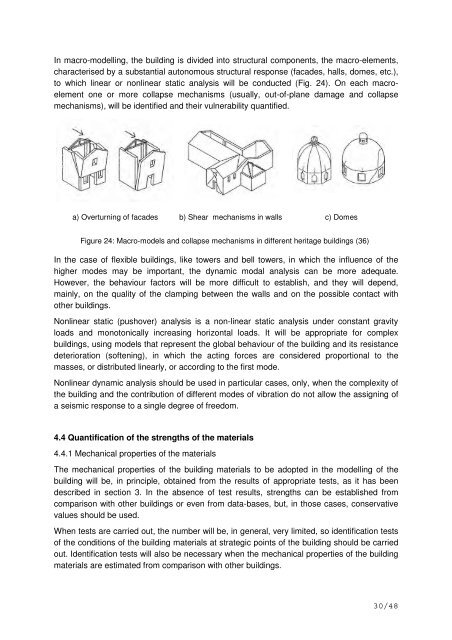Guide for the Structural Rehabilitation of Heritage ... - Test Input
Guide for the Structural Rehabilitation of Heritage ... - Test Input
Guide for the Structural Rehabilitation of Heritage ... - Test Input
Create successful ePaper yourself
Turn your PDF publications into a flip-book with our unique Google optimized e-Paper software.
In macro-modelling, <strong>the</strong> building is divided into structural components, <strong>the</strong> macro-elements,characterised by a substantial autonomous structural response (facades, halls, domes, etc.),to which linear or nonlinear static analysis will be conducted (Fig. 24). On each macroelementone or more collapse mechanisms (usually, out-<strong>of</strong>-plane damage and collapsemechanisms), will be identified and <strong>the</strong>ir vulnerability quantified.a) Overturning <strong>of</strong> facades b) Shear mechanisms in walls c) DomesFigure 24: Macro-models and collapse mechanisms in different heritage buildings (36)In <strong>the</strong> case <strong>of</strong> flexible buildings, like towers and bell towers, in which <strong>the</strong> influence <strong>of</strong> <strong>the</strong>higher modes may be important, <strong>the</strong> dynamic modal analysis can be more adequate.However, <strong>the</strong> behaviour factors will be more difficult to establish, and <strong>the</strong>y will depend,mainly, on <strong>the</strong> quality <strong>of</strong> <strong>the</strong> clamping between <strong>the</strong> walls and on <strong>the</strong> possible contact witho<strong>the</strong>r buildings.Nonlinear static (pushover) analysis is a non-linear static analysis under constant gravityloads and monotonically increasing horizontal loads. It will be appropriate <strong>for</strong> complexbuildings, using models that represent <strong>the</strong> global behaviour <strong>of</strong> <strong>the</strong> building and its resistancedeterioration (s<strong>of</strong>tening), in which <strong>the</strong> acting <strong>for</strong>ces are considered proportional to <strong>the</strong>masses, or distributed linearly, or according to <strong>the</strong> first mode.Nonlinear dynamic analysis should be used in particular cases, only, when <strong>the</strong> complexity <strong>of</strong><strong>the</strong> building and <strong>the</strong> contribution <strong>of</strong> different modes <strong>of</strong> vibration do not allow <strong>the</strong> assigning <strong>of</strong>a seismic response to a single degree <strong>of</strong> freedom.4.4 Quantification <strong>of</strong> <strong>the</strong> strengths <strong>of</strong> <strong>the</strong> materials4.4.1 Mechanical properties <strong>of</strong> <strong>the</strong> materialsThe mechanical properties <strong>of</strong> <strong>the</strong> building materials to be adopted in <strong>the</strong> modelling <strong>of</strong> <strong>the</strong>building will be, in principle, obtained from <strong>the</strong> results <strong>of</strong> appropriate tests, as it has beendescribed in section 3. In <strong>the</strong> absence <strong>of</strong> test results, strengths can be established fromcomparison with o<strong>the</strong>r buildings or even from data-bases, but, in those cases, conservativevalues should be used.When tests are carried out, <strong>the</strong> number will be, in general, very limited, so identification tests<strong>of</strong> <strong>the</strong> conditions <strong>of</strong> <strong>the</strong> building materials at strategic points <strong>of</strong> <strong>the</strong> building should be carriedout. Identification tests will also be necessary when <strong>the</strong> mechanical properties <strong>of</strong> <strong>the</strong> buildingmaterials are estimated from comparison with o<strong>the</strong>r buildings.30/48
















